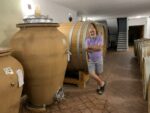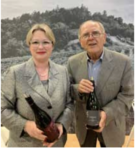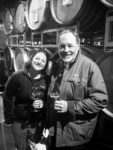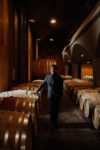Situated in the Jura, Domaine de lahaye is a family estate, attached to the local traditions. several generations of winemakers are still producing wines with a defined style and identity on the precious terroir of ChâteauChalon. Guillaume tissot is the 8th generation of Domaine de lahaye, who honors its terroir and traditions of the Jura and produces wines, reflecting the uniqueness of soils and traditional techniques of winemaking. he aims to transmit this heritage to future generations, working in the vineyard with attention and respect for the environment.
VertdeVin: Could you introduce yourself? Guillaume Tissot: I am a winemaker in the Jura, settled in 2003 with my father, with about 7 ha of vines, which my father planted in the 1970s. We are a family vineyard for several generations, producing wines of Côtes du Jura and Château-Chalon as well as Macvin, Marc, and Crémant du Jura.
Did you always want to become a winemaker?
G.T.: At some time I thought to do something different, but the attachment to the land and the heritage, finally, was stronger.
Was there something in particular that made you come back?
G.T.: No, I did a general course in college, then I continued on BAC in agronomy and the environment in the Lycée viticole of Beaune, and then – on BTS. I also worked in commerce and vineyards. Since 2001 I stay in the Jura, I worked with Philippe Butin and with my father. Since then I am still a winemaker.
How many hectares does your estate have today? How many cuvées do you make? Do you vinify 100% of your harvest? Do you buy grapes or do you sell them?
G.T.: The surface of the estate is almost the same nowadays because some plots were uprooted and replanted. We started with about 6 ha and now we have about 7 ha. We produce 11 cuvées : a floral white Côtes du Jura, two or three reds, depending on the harvest, a pure Savagnin in Côtes du Jura, vin jaune du Jura, Château Chalon, vin de paille, Crémant du Jura, Macvin and Marc du Jura.
You have a few red wines. Is it intentional?
G.T.: Indeed, I don’t make a lot of red wines. I still have a plot of Pinot Noir, which I had in the beginning, I also replanted Poulsard, but I don’t have terroir for the Trousseau variety. So we make a pure Pinot, a pure Poulsard, and a Pinot-Poulsard blend.
What is the common signature of your wines, which helps to recognise them in blind tastings? G.T.: Without pretension, our clients and wine professionals tell, us that our wines have an expressive and pure minerality. The oenologists qualify my Savagnin and my vin jaune as ”laser”, meaning that these wines are straight and pure from attack to finish. And that’s what makes them recognisable.
Where does the name of the estate come from?
G.T.: It comes from the surname of my maternal grandmother. There are a lot of Tissots in the Jura, so I would like to be different. Choosing this name for the estate, we wished to pay homage to my mother who has always worked in the vineyards.
Could you speak about the Château Chalon terroir?
G.T.: It is a unique terroir that gives minerality to our wines. We have blue marl and clay-limestone soils. This soil is not easy to work with, because when it is soaked with water, it becomes very clayey and sticks a lot. But it becomes very friable when it is dry, and it does not retain water. The roots are forced to go deep to feed the vine, and this is what gives our wines the profile that we can find in Château Chalon – this minerality, this salinity, and the aromas of leather. Our customers are very surprised when they taste our vin jaune from Savagnin, grown on gravels in Côtes du Jura and Château Chalon. They were amazed to think that it was the same vintage, the same winemaker, the same harvest period, the same aging cellar, and similar barrels, but the wines are different because the terroir is here.
Do you have any specific plans for the estate? G.T.: We have a quite demanding project of conversion to organic farming. The first certified organic vintage will be in 2024. We have also planted vines this spring because we are looking for expanding the production of Savagnin wines.
Why do you have a question mark on the etiquette of your wines? Is there an anecdote about your logo?
G.T.: In the beginning, we didn’t have all installations necessary to work in the vineyard close enough to the plots. And if we went to the vineyards, it was for the whole day. So, everyone had their own little house near the vines, which allowed them to have shelter in case of a storm, some shade in case of heat, and a stock of water for the day. And everyone tried to find a name for his house. The anecdote is linked with the name of such a small house, that my great-grandfather had also built for him in the vineyards. At that time there were two aviators Costes and Bellonte, who crossed the Atlantic with their plane called ”the question mark”. My great-grandfather was very interested in aeronautics and he had 5 found that it would be great to refer to this event, so he called his small house a ”question mark”.
Thanks to Guillaume Tissot for sharing his time and passion.
Valentina Guerin de Tourville
Domaine de Lahaye
45, impasse Jeanne d’arc
39210 nevy-sur-seille – france www.domainedelahaye.fr




